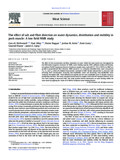| dc.contributor.author | McDonnell, Ciara K | |
| dc.contributor.author | Allen, Paul | |
| dc.contributor.author | Duggan, Elaine | |
| dc.contributor.author | Arimi, Joshua M | |
| dc.contributor.author | Casey, Eoin | |
| dc.contributor.author | Duane, Gearoid | |
| dc.contributor.author | Lyng, James G | |
| dc.date.accessioned | 2018-09-10T08:36:20Z | |
| dc.date.accessioned | 2020-02-06T15:26:09Z | |
| dc.date.available | 2018-09-10T08:36:20Z | |
| dc.date.available | 2020-02-06T15:26:09Z | |
| dc.date.issued | 2013 | |
| dc.identifier.uri | http://repository.must.ac.ke/handle/123456789/1130 | |
| dc.description.abstract | The effect of salt concentration and fibre orientation on water within the meat matrix was investigated by low-field nuclear magnetic resonance (LF-NMR), water-binding capacity (WBC), diffusion studies and histologyi-cal analysis. Pork M.longissimus thoracis et lumborum samples were cured with 5.7, 15.3 or 26.3% w/w NaCl at a parallel or perpendicular fibre direction. NMR transverse (T2) relaxationidenti fied three water components ( T2b,T21 and T 22) which all exhibited characteristics correlated to WBC. Results indicated that T 2b increases with increasing NaCl concentration. Increasing intra-myofibrillar water and decreasing extra-myofibrillar water resulted in the highest WBC. Water diffused more quickly into the extra-myofibrillar space in samples cured at a parallel fibre direction. This water remained loosely bound in samples cured with the saturated solution (26.3%w/w NaCl) leading to decreased WBC. This study provides further information on water binding within the meat matrix by applying the results of LF-NMR to traditional water-binding theories. | en_US |
| dc.language.iso | en | en_US |
| dc.publisher | Elsevier | en_US |
| dc.subject | NMR T 2 relaxation Curing Water-binding capacity Fibre direction. | en_US |
| dc.title | The effect of salt and fibre direction on water dynamics, distribution and mobility in pork muscle: A low field NMR study | en_US |
| dc.type | Article | en_US |

